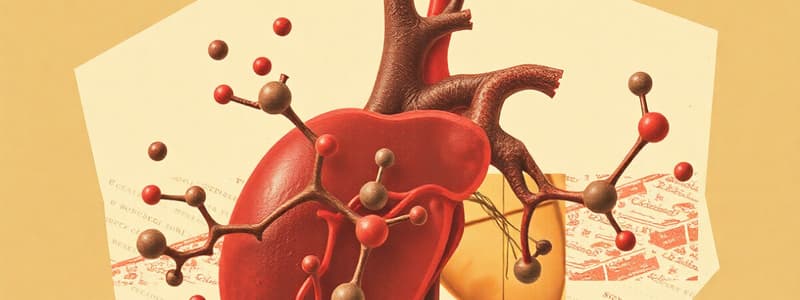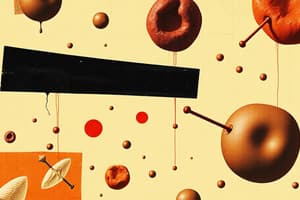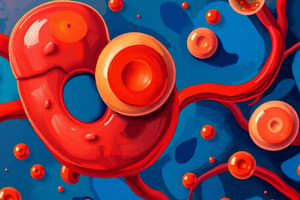Podcast
Questions and Answers
Which of the following is the primary function of lipoproteins in the body?
Which of the following is the primary function of lipoproteins in the body?
- To transport insoluble lipids in the blood. (correct)
- To regulate hormone production.
- To provide structural support to cell membranes.
- To act as enzymes in metabolic pathways.
What role does cholesterol play in the human body?
What role does cholesterol play in the human body?
- Facilitates the breakdown of proteins.
- Essential component for production of cell membranes, steroids, and bile acids. (correct)
- Primary source of energy for cells.
- Aids in the absorption of water-soluble vitamins.
Which lipoprotein is primarily responsible for transporting dietary triglycerides from the intestines to the liver, skeletal muscle, and adipose tissue?
Which lipoprotein is primarily responsible for transporting dietary triglycerides from the intestines to the liver, skeletal muscle, and adipose tissue?
- Chylomicrons. (correct)
- Low-density lipoprotein (LDL).
- Very-low-density lipoprotein (VLDL).
- High-density lipoprotein (HDL).
A patient’s blood test reveals high levels of LDL cholesterol. Which of the following is the most likely implication of this result?
A patient’s blood test reveals high levels of LDL cholesterol. Which of the following is the most likely implication of this result?
What is the function of High-density lipoprotein (HDL)?
What is the function of High-density lipoprotein (HDL)?
Which of the following non-modifiable risk factors contributes to the development of atherosclerosis?
Which of the following non-modifiable risk factors contributes to the development of atherosclerosis?
Which of the following modifiable risk factors is associated with the development of atherosclerosis?
Which of the following modifiable risk factors is associated with the development of atherosclerosis?
Which of the following is the initial step in the pathogenesis of atherosclerosis?
Which of the following is the initial step in the pathogenesis of atherosclerosis?
How does endothelial dysfunction contribute to the pathogenesis of atherosclerosis?
How does endothelial dysfunction contribute to the pathogenesis of atherosclerosis?
What role do macrophages play in the progression of atherosclerosis?
What role do macrophages play in the progression of atherosclerosis?
What is a 'fibrous cap' in the context of atherosclerosis, and what is its significance?
What is a 'fibrous cap' in the context of atherosclerosis, and what is its significance?
How does oxidized LDL contribute to the progression of atherosclerosis?
How does oxidized LDL contribute to the progression of atherosclerosis?
Which characteristic distinguishes a 'vulnerable' atherosclerotic plaque from a 'stable' plaque?
Which characteristic distinguishes a 'vulnerable' atherosclerotic plaque from a 'stable' plaque?
What is the primary consequence of plaque rupture in the context of atherosclerosis?
What is the primary consequence of plaque rupture in the context of atherosclerosis?
In the progression of atherosclerosis, what is the effect of limited nitric oxide (NO) availability?
In the progression of atherosclerosis, what is the effect of limited nitric oxide (NO) availability?
Flashcards
Lipoproteins
Lipoproteins
Packages of insoluble lipids transported in blood, including cholesterol, triglycerides, phospholipids, and protein.
HDL (High-Density Lipoprotein)
HDL (High-Density Lipoprotein)
The "good" cholesterol that carries cholesterol from arterial walls to the liver for processing and excretion.
Triglycerides
Triglycerides
A type of fat used in energy metabolism.
Cholesterol
Cholesterol
Signup and view all the flashcards
LDL (Low-Density Lipoprotein)
LDL (Low-Density Lipoprotein)
Signup and view all the flashcards
Chylomicrons
Chylomicrons
Signup and view all the flashcards
Atherosclerosis
Atherosclerosis
Signup and view all the flashcards
Endothelial Dysfunction
Endothelial Dysfunction
Signup and view all the flashcards
Fibrous Cap
Fibrous Cap
Signup and view all the flashcards
Atherosclerotic Plaque
Atherosclerotic Plaque
Signup and view all the flashcards
Study Notes
- Disorders of blood flow in the systemic circulation
Atherosclerosis - Lipids
- Lipoproteins are packages of insoluble lipids transported in blood.
- Lipoproteins include cholesterol, triglycerides, phospholipids, and proteins.
- Triglycerides are used in energy metabolism.
- Cholesterol produces cell membranes, steroids, and bile acid.
- Abnormal lipoprotein metabolism is a predisposing factor to atherosclerosis.
Lipoproteins Types
- HDL (high-density lipoprotein) is "GOOD" cholesterol.
- HDL removes cholesterol from arterial walls to the liver.
- LDL (low-density lipoprotein) deposits cholesterol in arterial walls.
- LDL accumulates in sub-endothelial space.
- VLDL (very-low-density lipoprotein) delivers triglycerides to cells for energy.
- Chylomicrons are the largest, least dense lipoproteins.
- Chylomicrons transport dietary triglycerides and cholesterol from the intestinal epithelial cells to the liver, skeletal muscle, and adipose tissue.
Aetiology of atherosclerosis
- Risk factors that cannot be modified:
- Familial hypercholesterolaemia
- Age and gender (men ≥45 years, women ≥55 years)
- Type 1 Diabetes Mellitus
- Modifiable risk factors:
- HDL cholesterol <40 mg/dL
- Elevated C-reactive protein (CRP) levels
- High homocysteine levels
Pathogenesis of atherosclerosis
- Formation of fibrofatty lesions in the intimal lining.
- Pathologic process that causes coronary, cerebral, peripheral arteries, and aorta diseases.
- There are three types of lesions associated with atherosclerosis: fatty streaks, fibrous atheromatous plaque, and complicated lesions.
- Development can begin in childhood with fatty streaks.
- Lesions of atherosclerosis advance with aging.
- Multiple factors contribute to pathogenesis, including endothelial dysfunction and dyslipidemia.
- Endothelium dysfunction is an active biologic interface between blood and tissues and is a risk factor effect.
- Dysfunction is due to loss of NO and microtears and leukocytes are recruited, starting the inflammatory process.
- Entry of circulating fat and cholesterol causes oxidisation of LDLs.
- This attracts circulating monocytes, which become macrophages to restore vessel wall integrity.
- Inflammatory mediators are released, and smooth muscle cells grow and enter.
- Macrophages and migrating smooth muscle cells consume ox-LDLs (foam cells).
- Oxidised LDL is cytotoxic at high levels, resulting in death of macrophages and smooth muscle cells.
- This causes deposition of cell contents and cholesterol crystals, leading to necrotic core formation in the arterial wall.
- Fibrous cap involves fibrin infiltration (stiffening wall), calcium deposition (hardening of vessel wall), and fibrous plaque with connective tissue and lipids.
Atherosclerotic plaque
- Continues to grow and cause narrowing of the vessel, which leads to production of ischemia.
- "Stable” plaque has a small lipid pool, thick fibrous cap and a preserved lumen.
- "Vulnerable” plaque has a large lipid pool, thin fibrous cap, and many inflammatory cells.
- "Vulnerable" plaque can commonly rupture and cause a thrombus, resulting in narrowing.
- Plaque progression involves two processes: chronic (slow narrowing) and acute (rapid luminal obstruction).
- Plaque cap splits, necrotic material traps platelets, and thrombus formation reduces size of or blocks artery lumen and limits NO to vasodilation.
Studying That Suits You
Use AI to generate personalized quizzes and flashcards to suit your learning preferences.




